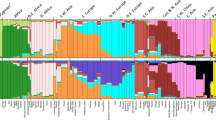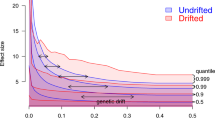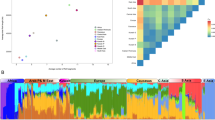Abstract
The choice of which population to study in the mapping of common disease genes may be critical1,2. Isolated founder populations, such as that found in Finland, have already proved extremely useful for mapping the genes for specific rare monogenic disorders3,4 and are being used in attempts to map the genes underlying common, complex diseases5,6,7,8. But simulation results suggest that, under the common disease-common variant hypothesis9,10,11,12,13, most isolated populations will prove no more useful for linkage disequilibrium (LD) mapping of common disease genes than large outbred populations12. There is very little empirical data to either support or refute this conclusion at present14,15,16. Therefore, we evaluated LD between 21 common microsatellite polymorphisms on chromosome 18q21 in 2 genetic isolates (Finland and Sardinia) and compared the results with those observed in two mixed populations (United Kingdom and United States of America). Mean levels of LD were similar across all four populations. Our results provide empirical support for the expectation that genetic isolates like Finland and Sardinia will not prove significantly more valuable than general populations for LD mapping of common variants underlying complex disease.
This is a preview of subscription content, access via your institution
Access options
Subscribe to this journal
Receive 12 print issues and online access
$209.00 per year
only $17.42 per issue
Buy this article
- Purchase on Springer Link
- Instant access to full article PDF
Prices may be subject to local taxes which are calculated during checkout



Similar content being viewed by others
References
Terwilliger, J.D. & Weiss, K.M. Linkage disequilibrium mapping of complex disease: fantasy or reality? Curr. Opin. Biotechnol. 9, 578–594 ( 1998).
Wright, A.F., Carothers, A.D. & Pirastu, M. Population choice in mapping genes for complex diseases . Nature Genet. 23, 397– 404 (1999).
de la Chapelle, A. & Wright, F.A. Linkage disequilibrium mapping in isolated populations: the example of Finland revisited. Proc. Natl Acad. Sci. USA 95, 12416– 12423 (1998).
Peltonen, L., Jalanko, A. & Varilo, T. Molecular genetics of the Finnish disease heritage. Hum. Mol. Genet. 8, 1913–1923 (1999).
Kuokkanen, S. et al. Genomewide scan of multiple sclerosis in Finnish multiplex families. Am. J. Hum. Genet. 61, 1379– 1387 (1997).
Escamilla, M.A. et al. Assessing the feasibility of linkage disequilibrium methods for mapping complex traits: an initial screen for bipolar disorder loci on chromosome 18. Am. J. Hum. Genet. 64, 1670 –1678 (1999).
Ghosh, S. et al. Type 2 diabetes: evidence for linkage on chromosome 20 in 716 Finnish affected sib pairs. Proc. Natl Acad. Sci. USA 96, 2198–2203 (1999).
Pajukanta, P. et al. Genomewide scan for familial combined hyperlipidemia genes in Finnish families, suggesting multiple susceptibility loci influencing triglyceride, cholesterol, and apolipoprotein B levels. Am. J. Hum. Genet. 64, 1453–1463 (1999).
Lander, E.S. The new genomics: global views of biology. Science 274, 536–539 (1996).
Risch, N. & Merikangas, K. The future of genetic studies of complex human diseases. Science 273, 1516–1517 (1996).
Collins, F.S., Guyer, M.S. & Charkravarti, A. Variations on a theme: cataloging human DNA sequence variation. Science 278, 1580– 1581 (1997).
Kruglyak, L. Prospects for whole-genome linkage disequilibrium mapping of common disease genes. Nature Genet. 22, 139– 144 (1999).
Todd, J.A. Multifactorial diseases: ancient gene polymorphism at quantitative trait loci and a legacy of survival during our evolution. in The Metabolic and Molecular Bases of Inherited Disease (eds Scriver, C.R. et al.) (McGraw-Hill, New York-London, in press).
Laan, M. & Paabo, S. Demographic history and linkage disequilibrium in human populations. Nature Genet. 17, 435–438 (1997).
Lonjou, C., Collins, A. & Morton, N.E. Allelic association between marker loci. Proc. Natl Acad. Sci. USA 96, 1621– 1626 (1999).
Jorde, L.B., Watkins, W.S., Kere, J., Nyman, D. & Eriksson, A.W. Gene mapping in isolated populations: new roles for old friends? Hum. Hered. 50, 57– 65 (2000).
Merriman, T. et al. Evidence by allelic-association dependent methods for a type 1 diabetes polygene (IDDM6) on chromosome 18q21. Hum. Mol. Genet. 6, 1003–1010 ( 1997).
Merriman, T.R. et al. Transmission of haplotypes of microsatellite markers rather than single marker alleles in the mapping of a putative type 1 diabetes susceptibility gene (IDDM6). Hum. Mol. Genet. 7, 517– 524 (1998).
Thomson, G. Mapping disease genes: family-based association studies. Am. J. Hum. Genet. 57, 487–498 (1995).
Lewontin, R.C. The interaction of selection and linkage. I. General considerations; heterotic models. Genetics 49, 49– 67 (1964).
Collins, A., Lonjou, C. & Morton, N.E. Genetic epidemiology of single-nucleotide polymorphisms . Proc. Natl Acad. Sci. USA 96, 15173– 15177 (1999).
Huttley, G.A., Smith, M.W., Carrington, M. & O'Brien, S.J. A scan for linkage disequilibrium across the human genome. Genetics 152, 1711–1722 ( 1999).
Reed, P.W. et al. Chromosome-specific microsatellite sets for fluorescence-based, semi-automated genome mapping. Nature Genet. 7, 390–395 (1994).
Weir, B.S. Genetic Data Analysis (Sinauer Associates, Sunderland, Massachusetts, 1996).
Hedrick, P.W. Gametic disequilibrium measures: proceed with caution. Genetics 117, 331–341 ( 1987).
Acknowledgements
This work was funded by the Wellcome Trust, British Diabetic Association (BDA), UK Medical Research Council and the Juvenile Diabetes Foundation International. We are grateful for the assistance of the ‘Childhood Diabetes in Finland (DiMe) Study Group’ in the collection of the Finnish family material. The Finnish family collaboration was partially funded by grants from NIH (DK 73957) and the Novo Nordisk Foundation. The BDA and the Human Biological Data Interchange are thanked for the collection of families. F.C. was supported in part by a grant from Assessorato Igiene e Sanità, Regione Sardegna.
Author information
Authors and Affiliations
Corresponding author
Rights and permissions
About this article
Cite this article
Eaves, I., Merriman, T., Barber, R. et al. The genetically isolated populations of Finland and Sardinia may not be a panacea for linkage disequilibrium mapping of common disease genes. Nat Genet 25, 320–323 (2000). https://doi.org/10.1038/77091
Received:
Accepted:
Issue Date:
DOI: https://doi.org/10.1038/77091



